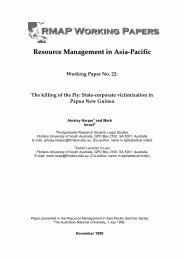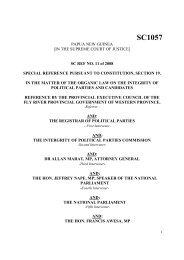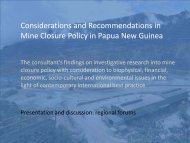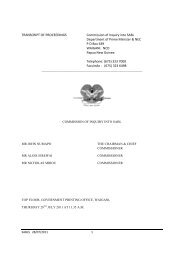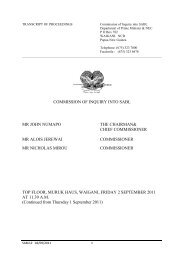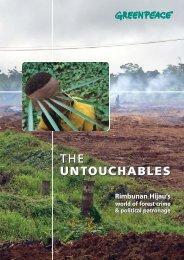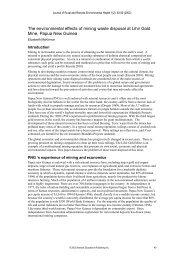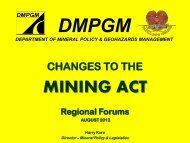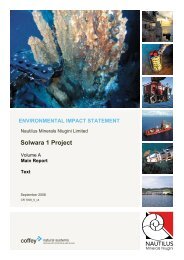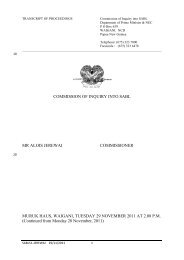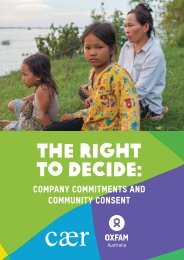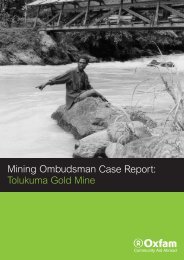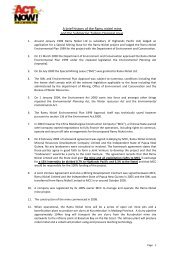Fishy business. The Social Impact of SST.pdf - Act Now!
Fishy business. The Social Impact of SST.pdf - Act Now!
Fishy business. The Social Impact of SST.pdf - Act Now!
You also want an ePaper? Increase the reach of your titles
YUMPU automatically turns print PDFs into web optimized ePapers that Google loves.
<strong>The</strong> Sepik <strong>of</strong>fice <strong>of</strong> WWF has a mandate from the Office <strong>of</strong> Environment and Conservation(OEC) and the Department <strong>of</strong> East Sepik (DES) to help the process <strong>of</strong> integrated developmentand conservation. This means identifying and where possible protecting conservation valueswhile working within a society shifting from a subsistence economy to a cash economy.Achieving this integration requires a healthy and active state and community. <strong>The</strong>OEC/DES/WWF agreement focuses on landowners in the Hunstein Range; but as the WWFSepik Community Land Care Project has evolved, it has become increasingly necessary for this<strong>of</strong>fice to become involved with development issues throughout the Sepik. This is in partbecause development options for the Hunstein will be shaped by development occurringelsewhere in the Sepik. In addition, we have found that both the local government andcommunity sectors have increasingly asked for assistance from WWF on a range <strong>of</strong>development issues throughout the Sepik.<strong>The</strong> <strong>SST</strong>C proposal, if successful, will have a major impact on the direction <strong>of</strong> development inthe Sepik. This in turn will influence civil society and therefore conservation values. HenceWWF's interest in the proposed tuna factory.<strong>Social</strong> and Infrastructural <strong>Impact</strong>sOf the issues raised previously by myself (see the attached February 2001 commentary) andlocal NGOs, the potential negative social impacts remain the most problematic. For example,the <strong>SST</strong>C says (S3.7 <strong>of</strong> the Environmental Plan Application) that the low wage structure inPNG is one reason for choosing this country. <strong>The</strong>re is indeed a pool <strong>of</strong> potentially employablepeople in Wewak, which <strong>of</strong>fers advantages for both the company and the township. However,potential problems arising from this include:•the creation <strong>of</strong> a pool <strong>of</strong> unemployed attracted to Wewak from the Sepik; and•a low wage structure failing to adequately compensate those moving from a non-cashsubsistence economy to a cash economy; in other words, factory workers may find theirpurchasing power provides a quality <strong>of</strong> life lower than available in the subsistence economy.<strong>The</strong> <strong>SST</strong>C says it intends to work with local government to address many <strong>of</strong> these issues, thatis:South Seas Tuna Corporation will carry out a baseline economic survey <strong>of</strong> its employees at thetime <strong>of</strong> their recruitment. This survey will help with long term monitoring (Section 9.3.4 p.9.9)and<strong>The</strong> South Seas Tuna Corporation will work wtih the Wewak Town Council, the East SepikProvincial Government and the relevant Utility Managers in a co-operative manner to helpthem improve the infrastructure <strong>of</strong> Wewak...(Section 9.3.4 p.9.9)With this in mind, WWF's Wewak <strong>of</strong>fice would like to work with the <strong>SST</strong>C, local level andprovincial government, to establish:•the provincial and local level strategic planning mechanisms available and/or required to allowthis to happen; for example, how does the tuna factory development fit in with the five yeardevelopment plans being prepared at district and provincial level?80



